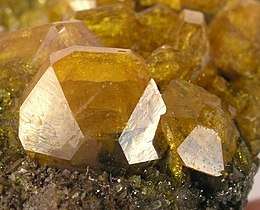Sturmanite
Sturmanite is a rare sulfate mineral with the chemical formula Ca6Fe3+2(SO4)2.5(B(OH)4)(OH)12 · 25 H2O.[1][2][3] It crystallises in the tetragonal system and it has a Moh's hardness of 2.5. Sturmanite has a bright yellow to amber colour and falls in the ettringite group. It was named after Bozidar Darko Sturman (born 1937), Croatian-Canadian mineralogist and Curator Emeritus of Mineralogy, Royal Ontario Museum.[4]
| Sturmanite | |
|---|---|
 Distinctive sturmanite on matrix from the N'Chwaning Mines. Size: 5.4 x 4.2 x 1.7 cm. Ex.Charlie Key Stock | |
| General | |
| Category | Sulfate minerals |
| Formula (repeating unit) | Ca6Fe3+2(SO4)2.5[B(OH)4](OH)12 · 25 H2O |
| Strunz classification | 7.DG.15 |
| Dana classification | 32.4.4.2 |
| Crystal system | Tetragonal (3m - Ditrigonal Pyramidal) |
| Unit cell | a = 11.188(9) Å, c = 21.91(7) Å |
| Identification | |
| Color | Bright yellow to amber |
| Crystal habit | Hexagonal, pyramidal, prismatic |
| Cleavage | Perfect {1010} |
| Tenacity | Brittle |
| Mohs scale hardness | 2.5 |
| Luster | Vitreous, greasy |
| Streak | Pale yellow, greenish yellow, brownish orange |
| Diaphaneity | Transparent to translucent |
| Specific gravity | 1.847 (measured) 1.855 (calculated) |
| Optical properties | Uniaxial (+/-) |
| Birefringence | δ = 0.002 |
| Ultraviolet fluorescence | none |
Occurrence
Sturmanite was first identified in 1983 and approved by the IMA in the same year.[3][4] It was first found in the Black Rock Mine, Black Rock, Kalahari manganese field, Northern Cape Province, South Africa. It is found as flattened dipyramidal crystals on hematite and baryte.[4] Sturmanite has also been identified in mines near the Black Rock Mine, such as the Wessel's and Perth mines, in the N'Chwaning mines, and near Lakargi Mountain in Russia.[1] It is found as a rare secondary mineral embedded in manganese deposits and is associated with baryte, manganite, hausmannite, and hematite.[2]
Crystal structure
The crystal structure of sturmanite shows two distinct features: one being columns of iron-octahedra and calcium polyhedra, the other being the SO4− and B(OH)4− tetrahedra surrounding these columns. These two structures are linked together through a dense and complex network of hydrogen bonds.[5]
References
- "Sturmanite: Sturmanite mineral information and data". www.mindat.org. Retrieved 2017-02-19.
- "Sturmanite" (PDF). Handbook of mineralogy.
- Barthelmy, Dave. "Sturmanite Mineral Data". www.webmineral.com. Retrieved 2017-02-19.
- Peacor, D.R., Dunn, P.J., Duggan, M. (1983). "Sturmanite, a ferric iron, boron analogue of ettringite". Canadian Mineralogist. 21: 705–709.CS1 maint: multiple names: authors list (link)
- Pushcharovsky, D.Y., Lebedeva, Y.S., Zubkova, N.V., Pasero, M., Bellezza, M., Merlino, S., Chukanov, N.V. (2004). "The crystal structure of sturmanite" (PDF). The Canadian Mineralogist. 42 (3): 723–729. CiteSeerX 10.1.1.605.4915. doi:10.2113/gscanmin.42.3.723.CS1 maint: multiple names: authors list (link)